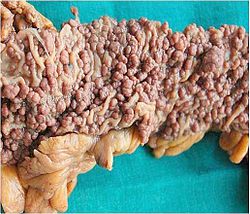Familial adenomatous polyposis
(Redirected from Gardner's syndrome)
Jump to navigation
Jump to search

Colectomy specimen with familial adenomatous polyposis. (WC/Netha Hussain)
Familial adenomatous polyposis, abbreviated FAP and also known as familial polyposis coli and adenomatous polyposis coli, is a genetic condition that predisposes to adenomatous polyps and thus invariably results in colorectal cancer.
Gardner syndrome[1] is a subset of FAP. Both FAP and Gardner syndrome have a mutation in the APC gene.[2]
General
- Life expectancy 40-50 years.[3]
Leading causes of death in FAP (according to The American Society of Colon and Rectal Surgeons):[4]
- Colorectal carcinoma.
- Desmoid tumour.
- Ampullary adenocarcinoma (a type of duodenal adenocarcinoma).
Inheritance
- Autosomal dominant.
Gene
- APC gene[2] mutation.
Variants
FAP comes in two main flavours:
- FAP (not otherwise specified - the plain vanilla flavour).
- Many polyps - typically > 100.
- Attenuated FAP, abbreviated AFAP.
Gardner syndrome
FAP with prominent extraintestinal manifestations - including:[5]
- Osteomas.
- Desmoid tumours.
- Congenital hypertrophy of the retinal pigment epithelium.
- Fibromas.
- Epidermal inclusion cysts.[2]
- Osteosclerotic jaw lesions.[2]
- Craniopharyngioma.[8]
Mneumonic DO STOP (modified):[9]
- Desmoid-type fibromatosis.
- Osteoma.
- Skin lesions - multiple lipomas.[7] ‡
- Thyroid carcinoma - papillary thyroid carcinoma cribriform morular variant.[2]
- Osteosclerotic jaw lesions.
- Polyps, adenomatous.
Note:
- Osteochondroma does not appear to be part of the syndrome, as suggested by pathologyexpert.com.[9]
- ‡ Sebaceous cysts are considered the classic lesion;[9][10] however, they are not considered a useful predictor of FAP.[7]
Turcot syndrome
The term is somewhat ambiguous and probably ought to be avoided:
- Half et al.[5] says Turcot syndrome is FAP associated with a medulloblastoma... while OMIM says Turcot syndrome is tied to Lynch syndrome and autosomal recessive.[2]
FAP associations
Benign things:
Malignant tumours:[5]
- Hepatoblastoma.
- Medulloblastoma.
- Colorectal carcinoma.
- Gastric adenocarcinoma.
- Papillary thyroid carcinoma cribriform-morular variant.[12]
Benign tumours:[5]
Prevalence
1/11,300-37,600 in Europe.[5]
Sign out
Possible polyposis
- Numerous tubular adenoma (10+) in short time period (<1 year).
Comment: The prior pathology is noted. The number of polyps raises the possibility of a polyposis syndrome.
See also
- Colorectal carcinoma.
- Adenomatous polyps.
- MUTYH polyposis syndrome - an autosomal recessive polyposis syndrome.
References
- ↑ Gardner, EJ. (Jun 1951). "A genetic and clinical study of intestinal polyposis, a predisposing factor for carcinoma of the colon and rectum.". Am J Hum Genet 3 (2): 167-76. PMID 14902760.
- ↑ 2.0 2.1 2.2 2.3 2.4 2.5 2.6 Online 'Mendelian Inheritance in Man' (OMIM) 175100
- ↑ Iwama, T.; Tamura, K.; Morita, T.; Hirai, T.; Hasegawa, H.; Koizumi, K.; Shirouzu, K.; Sugihara, K. et al. (Aug 2004). "A clinical overview of familial adenomatous polyposis derived from the database of the Polyposis Registry of Japan.". Int J Clin Oncol 9 (4): 308-16. doi:10.1007/s10147-004-0414-4. PMID 15375708.
- ↑ URL: http://www.fascrs.org/physicians/education/core_subjects/2006/fap/. Accessed on: 7 May 2012.
- ↑ 5.0 5.1 5.2 5.3 5.4 5.5 5.6 Half E, Bercovich D, Rozen P (2009). "Familial adenomatous polyposis". Orphanet J Rare Dis 4: 22. doi:10.1186/1750-1172-4-22. PMC 2772987. PMID 19822006. https://www.ncbi.nlm.nih.gov/pmc/articles/PMC2772987/.
- ↑ Knudsen, AL.; Bülow, S.; Tomlinson, I.; Möslein, G.; Heinimann, K.; Christensen, IJ.; Aretz, S.; Berk, T. et al. (Oct 2010). "Attenuated familial adenomatous polyposis: results from an international collaborative study.". Colorectal Dis 12 (10 Online): e243-9. doi:10.1111/j.1463-1318.2010.02218.x. PMID 20105204.
- ↑ 7.0 7.1 7.2 Burger, B.; Cattani, N.; Trueb, S.; de Lorenzo, R.; Albertini, M.; Bontognali, E.; Itin, C.; Schaub, N. et al. (2011). "Prevalence of skin lesions in familial adenomatous polyposis: a marker for presymptomatic diagnosis?". Oncologist 16 (12): 1698-705. doi:10.1634/theoncologist.2011-0244. PMID 22135120.
- ↑ Aquilina, K.; O'Brien, DF.; Farrell, MA.; Bolger, C. (Aug 2006). "Primary cerebellopontine angle craniopharyngioma in a patient with gardner syndrome. Case report and review of the literature.". J Neurosurg 105 (2): 330-3. doi:10.3171/jns.2006.105.2.330. PMID 17219843.
- ↑ 9.0 9.1 9.2 URL: http://www.pathologyexpert.com/boards/onlinefiles/syndromes.htm. Accessed on: 26 November 2011.
- ↑ Bisgaard, ML.; Bülow, S. (Feb 2006). "Familial adenomatous polyposis (FAP): genotype correlation to FAP phenotype with osteomas and sebaceous cysts.". Am J Med Genet A 140 (3): 200-4. doi:10.1002/ajmg.a.31010. PMID 16411234.
- ↑ Freeman HJ (March 2008). "Proton pump inhibitors and an emerging epidemic of gastric fundic gland polyposis". World J. Gastroenterol. 14 (9): 1318-20. PMID 18322941. http://www.wjgnet.com/1007-9327/14/1318.asp.
- ↑ Groen EJ, Roos A, Muntinghe FL, et al. (September 2008). "Extra-intestinal manifestations of familial adenomatous polyposis". Ann. Surg. Oncol. 15 (9): 2439–50. doi:10.1245/s10434-008-9981-3. PMC 2518080. PMID 18612695. http://www.ncbi.nlm.nih.gov/pmc/articles/PMC2518080/?tool=pubmed.
